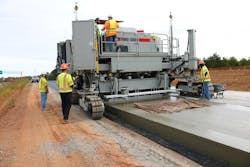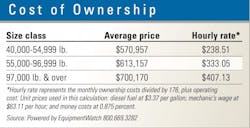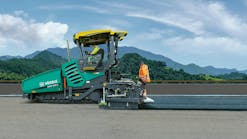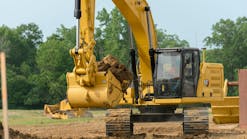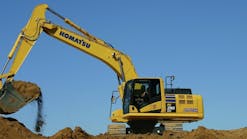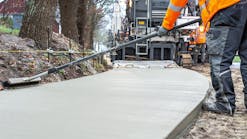Though the products do not undergo “new model-level” changes nearly as often as other pieces of equipment, slipform paver makers are constantly tweaking and making improvements, particularly in technology. Good maintenance practices, however, do not change.
How to manage slipform paver costs
“Good maintenance is essential to minimizing operating costs on a concrete slipform paver after the purchase,” says Fred Bryan, VP of sales at Power Curber Companies. “Assessing the machine regularly to identify any potential issues before they show up in the middle of a pour can save concrete, labor, and time.
“Another way to maximize efficiency while paving is to consider your concrete supply,” Bryan says. “The quality of the finished surface will be higher if you can eliminate stopping and starting while paving. Work with your supplier to plan the best rate of trucks, and coach your operator to pave at the same speed that the concrete arrives.”
Pay particular attention to grease and lubrication, along with other aspects of set-up, says GOMACO University director of training Rob Schneider.
“Reading the operator’s manual for tips and tricks to reduce set-up time and learn all capabilities of the equipment will result in reduced operating costs,” Schneider says. “Knowing the correct setup of the equipment will also result in a superior concrete product when it leaves the machine.”
Miller Formless VP of business development for North America and former construction company owner Darick Franzen touches on another aspect of set-up and performance. “Keep your machinery clean, pressure wash it,” he says. “Residue from materials like concrete or aggregates can increase wear on parts. Keeping your machine clean of these materials will increase its years of service and help with resale—and a clean machine helps you look good.”
Maintenance tips for slipform pavers
Drilling beyond the basics of slipform concrete paver maintenance also aids in performance. Schneider recommends oil analysis.
“Analyzing oil samples from the hydraulic reservoir after each engine oil change can give maintenance personnel a preview of what is happening with their equipment,” Schneider says.
GOMACO samples and analyzes the hydraulic oil during the final testing of each machine as a baseline test, which can be helpful to contractors as they begin to use the machine.
“This baseline can be compared to successive testing to determine if a hydraulic system issue is arising before it causes a major failure on the job site,” Schneider says. “In addition, the operator’s manual includes a checklist at the beginning of the maintenance chapter, which could be copied and laminated for interval reference to ensure correct lubrication.”
Also consider the use of a form-release agent before each pour.
“A maintenance trick that helps tremendously but often gets overlooked is to apply a form-release agent,” Bryan says. “Machine cleanliness is essential for high-quality paving. Tiny amounts of concrete wedged in the wrong corner can cause major headaches, so a form-release agent applied before pouring makes end-of-day cleanup far easier and faster.”
Using the latest technology offerings will also benefit managers looking to save operating costs and achieve efficiencies.
“Although G+ controllers have been released for years now, the continuous updates to that platform have advanced control systems across the board on all GOMACO machine models,” says Kevin Klein, the company’s VP of research and development.
Klein says the updates are meant to improve safety and machine performance in areas such rideability. They have also involved access to machine settings for troubleshooting, radius control software, GSI, dual display controls, attachment operation, and controls such as TBIs, SBIs, DBIs. Additional sensors added to different parts of the machine, such as smart cylinders and speed sensors, also help monitor and improve performance.
Telematics plays a role, as well. GOMACO, for example, has GOMACO Remote Diagnostics (GRD).
“GRD is a huge benefit for the equipment manager,” Klein says. “It provides an excellent platform for accessing the machine and crew performance during the paving day. It can also be used for troubleshooting day-to-day issues that arise. GOMACO service technicians can access the machine to troubleshoot.
“GRD can be used to download new machine control software as new code developments are implemented,” Klein says. “It can track and institute maintenance schedules on the equipment from remote locations such as the equipment manager’s office or construction vehicle. It also provides engine alerts, which is big due to the most recent emissions standards on diesel engines.”
Stringless machine-control technology continues to gain acceptance, a trend that will continue.
“3D/stringless guidance technology isn’t as new as it once was, but we still talk about it all the time and it is the most significant technological advancement in the industry in decades,” Bryan says. “Power Curbers & Power Pavers has a proven, successful history with the three largest guidance system suppliers.”
Market trends in concrete pavers
Construction Equipment asked slipform concrete paver OEMs about their market before the infrastructure bill was passed by Congress in early November. At the time, supply chain issues and labor shortages weighed heavy on their minds.
“The current market at this point is up in terms of overall industry optimism and attitude towards the [then] pending infrastructure bill,” Franzen says. “Certainly, the infrastructure bill will be positive news for the industry. However, the shortage of workers and the continued global supply chain issues are in fact creating some uncertainty as to how to proceed with planning and scheduling.
“Customers are concerned about availability of equipment and supplies, and we as manufacturers are struggling to keep up with the changing lead times and costs increases from our vendors,” Franzen says. “Our customers tell us time and time again they are busy and could grow their businesses but are unable to do so due to the shortage of workers. Covid certainly has created challenging times for us all.”
Kent Godbersen, GOMACO’s VP of worldwide sales and marketing, says he has seen a somewhat flat market for concrete paving equipment in 2021. “There are several factors which have contributed to this, but the two prominent ones in my view are the ongoing side effects of Covid-19 and the continual delay in the passage of the much-needed infrastructure bill. Passage of a robust infrastructure package will help rebuild the economy, increase employment, and begin the process of revitalizing our aging infrastructure system.”
Power Curbers’ Bryan agrees on Covid’s effects, but sees the next two years positively.
“The market for slipform concrete pavers has been negatively affected by the pandemic,” he says. “A variety of causes are to blame, ranging from Capitol gridlock over an infrastructure bill to labor shortages. Internationally, developing markets with an abundance of planned roadbuilding have been the hardest hit by Covid.
“Fortunately, things are getting better. Developing countries’ access to the vaccines is increasing and they are getting back to work,” Bryan says. “I expect that slipform paving will gradually increase over 2022 and reach pre-pandemic levels some time in 2023.”
